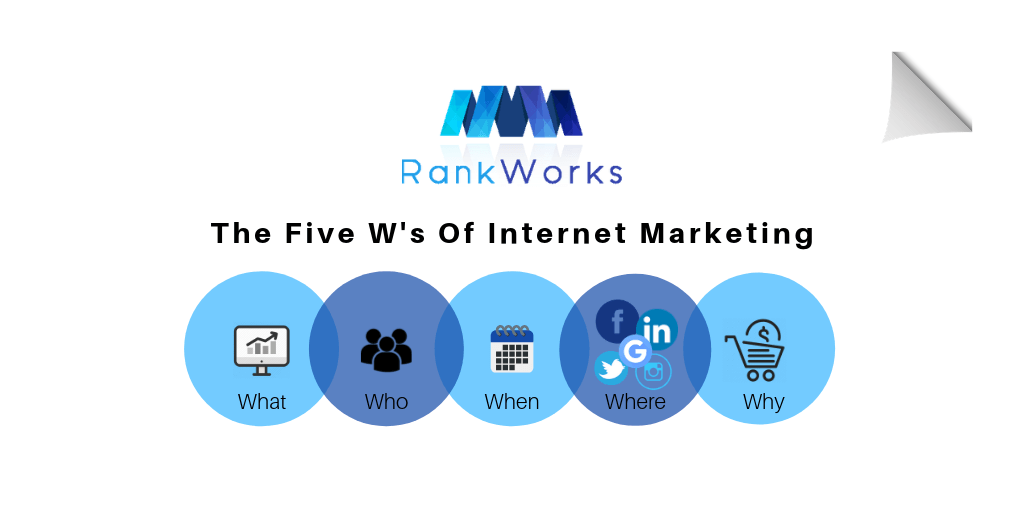Yielding Stronger Results From Online Marketing Campaigns
Written by: Dan Alper
In professional journalism the first thing a reporter asks is if a story is news worthy. If it is news worthy, the story should have the five W elements such as who, what, when, where, and why to substantiate the story’s credibility.
The same five W’s in journalism can be applied to internet marketing and every business owner should use this strategy before spending their precious money advertising online.
Let’s use company XYZ as an example. This company sells a service or product in a small market but is looking to expand and grow. The owner of company XYZ has decided that they will attract new clients through some method of online marketing and now they need to figure out what kind of budget they will apply to perform an effective marketing campaign.
Like the professional journalist, let’s apply the same five W strategy to company XYZ.
Who: Who is the service or product being marketed to? Demographics is an important detail when launching an online marketing campaign. Knowing who to target with ads is detrimental to the success of the ad campaign. A Facebook ad campaign has effective tools that allows the campaign manager the ability choose a specific kind of profile to target. They can assign targeting rules to the ad campaign based on gender, age, interests, education, etc. By doing this, a digital marketer is narrowing down the population that will view the ad and therefore making the ad more effective.
What: What is the service or product? what is its value? And what is the strategy of the competition? A company should know everything about the product or service that they are marketing. They should be the expert in their industry and when a potential client shows interest in making a purchase, the company is able to answer any questions that are asked during the sales cycle. The ability to reassure the client that they are getting the best value for their money is important because they might have no idea that company XYZ existed before they were targeted with an ad and now they are researching everything online about company XYZ and its competition. Therefore, knowing the competition and their marketing strategy is very important when considering pricing, keyword targeting, geo targeting, and client satisfaction.
When: When will the marketing campaign begin? When will the marketing campaign end? This is called flight date. When assessing when to launch an ad campaign, the flight date should account for the time of year, time of day, and state of the marketplace. There are many different strategies to consider with flight dates. A company should know when they are at peak sales season and when they are at off-season. When advertising at peak sales season chances are there will be a lot more competition who are advertising on the same online platforms, fighting to convert the same potential pool of clients. This will increase the cost of conversion because the marketing campaign will cost a lot more to run. On the flip side, if company XYZ chooses to launch their campaign during off-season the cost per conversion will be a lot less given that there is less advertising competition. However, the pool of clients looking to make a purchase will be a lot smaller. Understanding that the cost per conversion is related to flight dates is an essential metric that needs to be examined when planning an online advertising campaign.
Where: Where is the marketing campaign being geo-targeted to? Where is the service or product being sold and delivered? Geography plays an important role when creating customized and targeted marketing campaigns. Google, Facebook, Instagram, Snap Chat, YouTube, etc… all have geo-targeting functions built into their advertising platforms. As local search technology becomes more advanced and location data becomes more accurate, it’s good practice to test different geo-targeting options to reach a target audience. Geo-targeted mobile ads are extremely effective at attracting clients to a company’s location and increasing sales. Geo-targeting is also a good tool that allows marketers the ability to exclude locations where a company’s target audience will not be. It’s a cost effective way to avoid expensive ad rates in high demand areas and eliminates wasted advertising dollars in areas that will not return results.
Why: Why are you showing the target audience the ad? Why did the client order the service or product? Is the product or service fulfilling a client’s needs or wants? Are they satisfied with what they purchased? Can they be upsold or re-sold in the future? Understanding “why” is vital to knowing how to communicate with your customers. Converting a new client from an online ad is essential for hitting the ROI metrics. Whether company XYZ is looking for clicks, phone calls, or a form completion will shape the entire marketing strategy. However, understanding the needs of that client and knowing if a customer can be upsold or re-sold in the future is far more valuable to the success of the campaign. A satisfied customer will happily order products and services repeatedly. They will also recommend the company to their social network. Furthermore, a satisfied customer can potentially leave a valuable Google review or write a positive testimonial on Facebook.
Applying the five W’s to digital marketing campaigns can be time consuming but the commitment to this process will create a much higher return on investment and yield stronger results. For more information or to discuss how RankWorks can help with your company’s online marketing strategy please contact us to set up a free online business evaluation.


